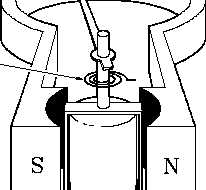Test Instruments & Measuring Devices
METER MOVEMENTS
METER MOVEMENTS
There are three basic meter movements utilized in electrical meters: D’Arsonval,
electrodynamometer, and the moving iron vane. Some meter movements can be
used for both AC or DC measurements, but in general, each meter movement is
best suited for a particular type.
EO 1.1
EXPLAIN the following meter movements:
a.
D’Arsonval
b.
Electrodynamometer
c.
Moving iron vane
D’Arsonval Movement
The most commonly used sensing mechanism used in DC ammeters, voltmeters, and ohm meters
is a current-sensing device called a D’Arsonval meter movement (Figure 1). The D’Arsonval
movement is a DC moving coil-type movement in which an electromagnetic core is suspended
between the poles of a permanent magnet.
The current measured is directed
Figure 1 D’Arsonval Meter Movement
through the coils of the electromagnet
so that the magnetic field produced by
the current opposes the field of the
permanent magnet and causes rotation
of the core. The core is restrained by
springs so that the needle will deflect
or move in proportion to the current
intensity. The more current applied to
the core, the stronger the opposing
field, and the larger the deflection, up
to the limit of the current capacity of
the coil.
When the current is
interrupted,
the
opposing
field
collapses, and the needle is returned to
zero by the restraining springs. The
limit of the current that can be applied
to this type movement is usually less
than one milliampere.
Rev. 0
Page 1
ES-14


